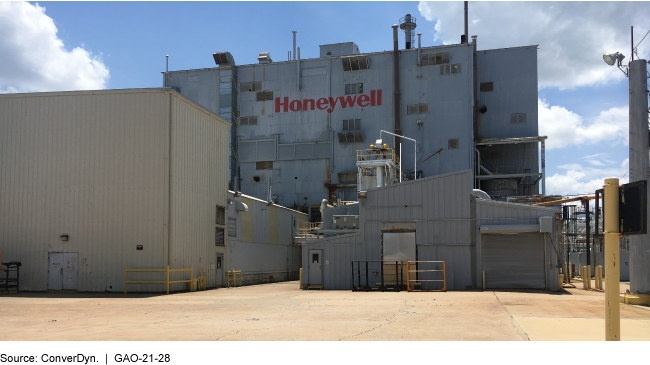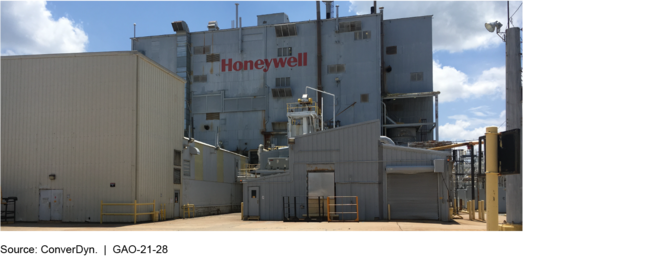Uranium Management: Actions to Mitigate Risks to Domestic Supply Chain Could Be Better Planned and Coordinated
Fast Facts
The National Nuclear Security Administration relies on the commercial uranium industry to produce uranium for nuclear weapons and other national security missions. Under international agreements such uranium must be mined in the U.S. and enriched using U.S. technology. However, the U.S. has not had the capability to produce such uranium since 2013.
The U.S. released a new national strategy to address the concerns expressed by domestic uranium industry and support new uranium production. However, the strategy could be improved—for instance, by identifying the resources needed to carry it out. We recommended strategy improvements and more.
Idle Domestic Plant for Converting Uranium to a Form Suitable for Enrichment

Highlights
What GAO Found
Federal agencies, including the Department of Energy (DOE) and the separately organized National Nuclear Security Administration (NNSA) within DOE, and uranium industry representatives have identified risks to the commercial supply chain for uranium needed for defense purposes. Such uranium may need to be mined domestically and enriched using U.S. technology to be free of obligations for the peaceful use of uranium and certain technology imported under international agreements. Identified risks to the unobligated uranium supply chain include (1) possible loss of domestic uranium mining capabilities and (2) possible challenges in re-starting the only facility in the United States for converting natural uranium into a form suitable for use in enrichment operations. Further, the U.S. has not had an operating enrichment capability that uses U.S. technology since 2013.
Idle Domestic Plant for Converting Uranium to a Form Suitable for Enrichment

DOE and NNSA have initiated actions officials believe will mitigate such risks to the unobligated uranium supply chain. For example, DOE and NNSA have both taken steps to reestablish a domestic enrichment capability with U.S. technology. In addition, DOE has proposed creation of a domestic uranium reserve to help support the domestic uranium mining and conversion industries until market conditions improve. DOE's fiscal year 2021 budget request includes $150 million for the reserve. However, we cannot conclude that the estimate is reasonable because it is unclear how the funding needs for the reserve were determined. By providing a more complete analysis to support future funding requests for the reserve, DOE could better provide assurance that such requests would achieve objectives.
The Nuclear Fuel Working Group's strategy to mitigate risks to the domestic uranium industry does not fully incorporate all desirable characteristics GAO has identified for a national strategy. For example, it does not identify (1) the level of resources needed to support proposed actions or (2) an interagency coordinating mechanism. DOE is developing an implementation plan for the strategy, but DOE officials provided conflicting statements about the extent to which the agency will coordinate interagency implementation.
Why GAO Did This Study
NNSA has several defense needs for enriched uranium, including low-enriched uranium to produce tritium for nuclear weapons. To meet these needs, NNSA relies on commercial sectors of the domestic uranium industry, such as uranium mining or enrichment, which make up a supply chain for unobligated uranium. However, this industry faces commercial viability risks. In April 2020, the President's Nuclear Fuel Working Group released a strategy to mitigate risks to the domestic uranium industry. This working group includes DOE, the Department of Defense, and other agencies.
Senate Report 115-262 included a provision that GAO review NNSA's planning for the future supply of unobligated enriched uranium. This report examines (1) risks agencies and others have identified to the unobligated uranium supply chain and agency actions to mitigate those risks, and (2) the extent to which the Nuclear Fuel Working Group's risk mitigation strategy incorporates desirable characteristics of a national strategy. GAO analyzed key NNSA and DOE planning documents and interviewed NNSA and other agency officials and industry representatives.
Recommendations
GAO is making three recommendations, including that DOE improve its cost estimate to support future funding requests for the proposed uranium reserve and ensure its implementation plan for the strategy addresses each of the desirable characteristics of a national strategy. DOE concurred with GAO's recommendations.
Recommendations for Executive Action
| Agency Affected | Recommendation | Status |
|---|---|---|
| Department of Energy | The Secretary of Energy should ensure, particularly as operational details for the uranium reserve are clarified, that any future funding requests for the uranium reserve are based on cost estimates that have been thoroughly reviewed and deemed reasonable. (Recommendation 1) |
The Department of Energy (DOE) began implementing the uranium reserve in the summer of 2022, including issuing a procurement solicitation. DOE officials told us that they have never requested any additional funding for the reserve since the initial fiscal year 2021 appropriation and have no plans to do so in the future. Instead, they told us that if the agency has need for additional uranium in the future, they will buy uranium from commercial suppliers to meet those needs. However, we are keeping the recommendation open in the event DOE decides to change its plans in the future and seek funding for the reserve. We will continue to check with DOE annually on whether it intends to change its plans and seek new funding for a uranium reserve.
|
| Office of Cost Estimating and Program Evaluation | The Director of NNSA's Office of Cost Estimating and Program Evaluation should, during the office's required review of NNSA's analysis of alternatives (AOA) for a capability to meet NNSA's future unobligated enriched uranium needs, ensure that the AOA was unbiased toward any solution. (Recommendation 2) |
NNSA agreed with our recommendation and stated that its Office of Cost Estimating and Program Evaluation would conduct a review of the Domestic Uranium Enrichment program's Analysis of Alternatives (AOA) process one month after completion of the AOA to ensure technical soundness and reasonableness of the cost and schedule estimates of the selected uranium enrichment option. NNSA officials told us in May 2021 that they had paused the AOA process to allow time for further maturation of the two technologies included in the AOA. NNSA officials told us at that time that they intended to resume the AOA in the mid-2020s. We continued monitoring the status of the AOA process through semiannual contacts with NNSA officials. In a June 2024 meeting, NNSA officials told us that the agency had abandoned its plan to select a single enrichment capability among the two options being considered under the AOA, and that it would not be pursuing a capital acquisition project to meet its future enriched uranium needs. As a result, NNSA officials told us that the agency had terminated the AOA process. We anticipate reviewing any new enrichment capability plans NNSA might develop in our future work.
|
| Department of Energy | The Secretary of Energy should ensure that the implementation plan under development for Restoring America's Competitive Nuclear Energy Advantage: a Strategy to Assure U.S. National Security fully addresses each of the desirable characteristics GAO has identified for a national strategy. (Recommendation 3) |
In January 2023, DOE informed GAO that the plan DOE prepared for the 2020 Restoring America's Competitive Nuclear Energy Advantage: a Strategy to Assure U.S. National Security was developed in the prior administration and the current administration has not carried it forward. Because DOE is not intending to follow the plan, and because the recommendation no longer applies due to the changed circumstances, we are closing this recommendation as not implemented.
|
